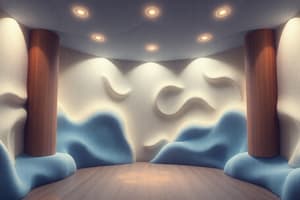Podcast
Questions and Answers
What is the minimum height of a barrier required to effectively block 2354 Hz sound waves in an open space, given a wavelength of 11 ft?
What is the minimum height of a barrier required to effectively block 2354 Hz sound waves in an open space, given a wavelength of 11 ft?
- 30 ft
- 25 ft
- 50 ft (correct)
- 20 ft
What is the primary function of a sound barrier near a sound source?
What is the primary function of a sound barrier near a sound source?
- To redirect sound energy away from potential receivers (correct)
- To increase the amplitude of the sound
- To reduce the frequency of the sound
- To absorb sound energy
At which frequency does a sound barrier become less effective with increasing distance between the barrier and the sound source?
At which frequency does a sound barrier become less effective with increasing distance between the barrier and the sound source?
- 100 Hz
- 500 Hz
- Any frequency (correct)
- 1000 Hz
What is the purpose of placing workers in sound-treated control rooms or offices?
What is the purpose of placing workers in sound-treated control rooms or offices?
What is the least acceptable method of noise control?
What is the least acceptable method of noise control?
What is the wavelength of a 100 Hz sound wave, if a barrier 5 times the wavelength is required to create a sound shadow?
What is the wavelength of a 100 Hz sound wave, if a barrier 5 times the wavelength is required to create a sound shadow?
What is the purpose of the described curtains?
What is the purpose of the described curtains?
What material is used in the described Low Frequency Sound Absorber?
What material is used in the described Low Frequency Sound Absorber?
In what range of thicknesses are the curtains available?
In what range of thicknesses are the curtains available?
What is the primary function of the Anechoic Wedges pattern described for the Low Frequency Sound Absorber?
What is the primary function of the Anechoic Wedges pattern described for the Low Frequency Sound Absorber?
What is the purpose of enclosing a sound source?
What is the purpose of enclosing a sound source?
What type of structure are the described Acoustical Enclosures made of?
What type of structure are the described Acoustical Enclosures made of?
How does sound absorption work in an enclosure?
How does sound absorption work in an enclosure?
What additional feature is not mentioned as part of the Complete Systems for the Acoustical Enclosures?
What additional feature is not mentioned as part of the Complete Systems for the Acoustical Enclosures?
What is a common problem associated with simply placing a solid enclosure over a sound source?
What is a common problem associated with simply placing a solid enclosure over a sound source?
Why are some sound sources challenging to enclose?
Why are some sound sources challenging to enclose?
What should the sides of an enclosure contain to be effective in reducing noise?
What should the sides of an enclosure contain to be effective in reducing noise?
What are some effective methods for isolating noise in the workplace?
What are some effective methods for isolating noise in the workplace?
Flashcards are hidden until you start studying
Study Notes
Sound Absorption and Noise Control
- Soundwave melamine foam sound absorber is a class A fire retardant high-performance sound absorber.
- A barrier in the near field can be effective in reducing sound levels, but its effectiveness decreases as the distance between the barrier and the sound source increases.
- For a 100 Hz frequency, a barrier must be approximately 5λ high to create a sound shadow.
Barrier Types
- Lead curtains, drapes, or solid shields can be used as barriers to redirect sound energy away from receivers or absorb sound.
- Quilted curtains can be used as noise barriers.
- Outdoor wall barriers can be effective in reducing sound levels.
Noise Control Methods
- Placing a barrier in the near field can reduce sound levels.
- Enclosing the receiver, such as placing workers in sound-treated control rooms, can also reduce noise exposure.
- Removing the receiver from the noise or using hearing protectors as a last resort can also be effective.
- Removing the noise source or reducing the noise level at the source is the most effective method.
Acoustic Materials
- Open-cell melamine acoustic foam is a durable, high-performance sound absorber.
- Convoluted double hump anechoic wedges and SonexT patterns are available for sound absorption.
- The material is available in various thicknesses, sizes, and colors, and is suitable for industrial, commercial, and residential applications.
Enclosures and Treatment
- Enclosing the sound source can be an effective method of noise control.
- Isolation of the noise source can be achieved by moving machinery to remote areas, enclosing machines with sound-absorbing material, or fitting flexible screens or curtains around the machinery.
- Enclosing the sound source must include sound-absorbing material on all sides, as a solid enclosure can be ineffective.
Studying That Suits You
Use AI to generate personalized quizzes and flashcards to suit your learning preferences.




